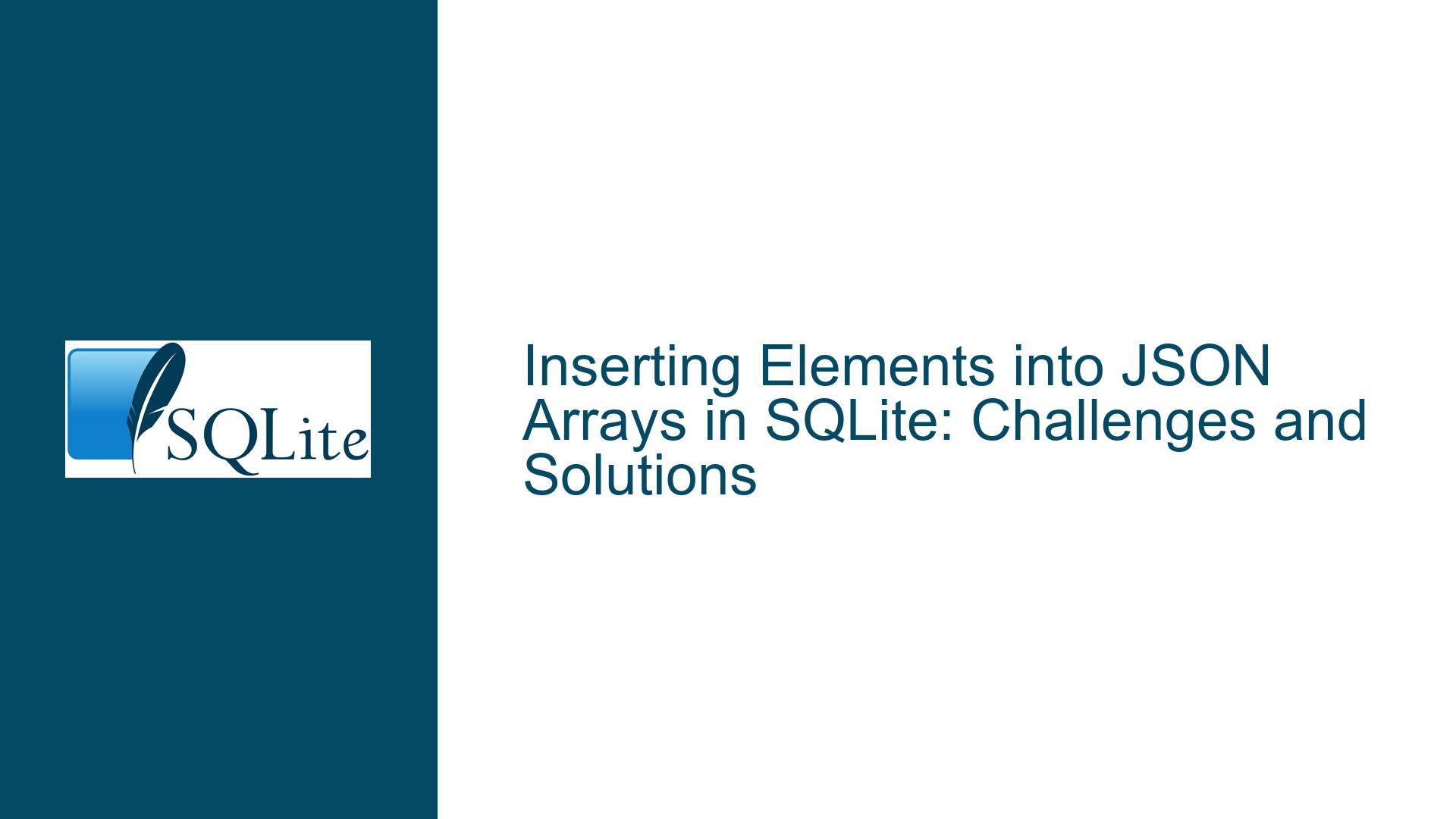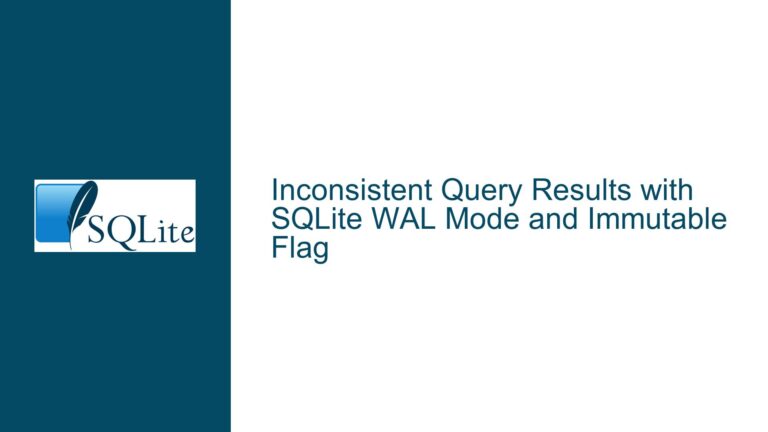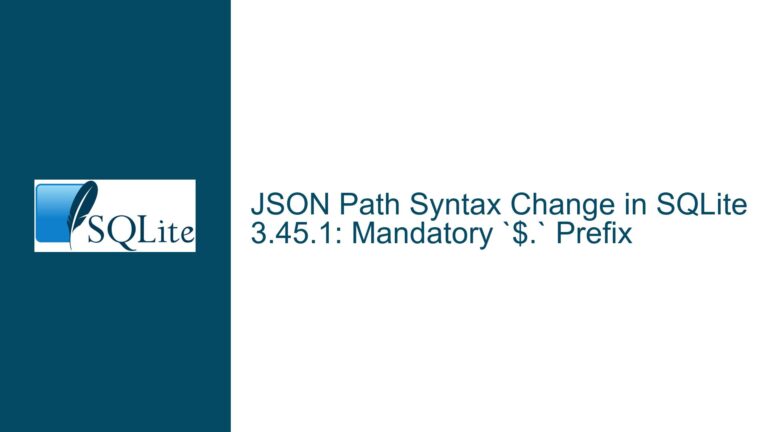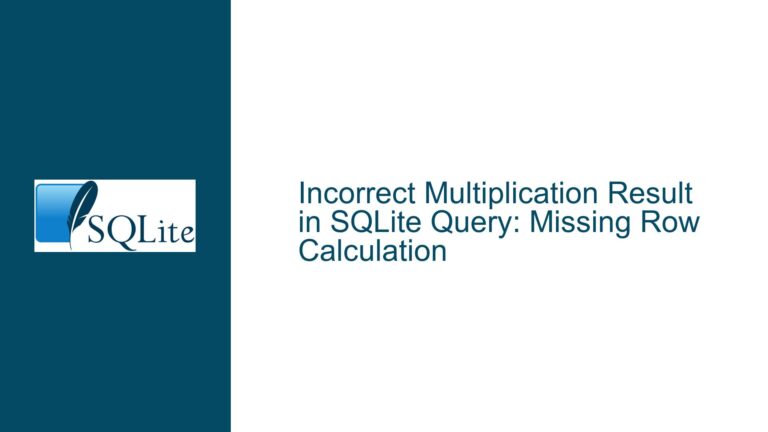Inserting Elements into JSON Arrays in SQLite: Challenges and Solutions
Understanding JSON Array Manipulation in SQLite
JSON (JavaScript Object Notation) has become a ubiquitous data format for storing and exchanging information, especially in web applications and APIs. SQLite, being a lightweight and versatile database engine, has embraced JSON by introducing native JSON support in version 3.9.0. This allows developers to store, query, and manipulate JSON data directly within SQLite databases. However, one of the challenges that developers often face is manipulating JSON arrays, particularly inserting elements into specific positions within an array. Unlike MySQL, which provides a dedicated function like JSON_ARRAY_INSERT, SQLite does not offer a built-in function for this purpose. This limitation can lead to confusion and inefficiencies when working with JSON arrays in SQLite.
The core issue revolves around the need to insert an element into a specific position within a JSON array stored in an SQLite database. For example, consider a JSON array [1, 2, 3, 4], and the goal is to insert the number 5 at index 2, resulting in [1, 2, 5, 3, 4]. In MySQL, this operation is straightforward using the JSON_ARRAY_INSERT function. However, SQLite lacks a direct equivalent, necessitating alternative approaches to achieve the same result.
Why SQLite Lacks a Direct JSON_ARRAY_INSERT Function
The absence of a direct JSON_ARRAY_INSERT function in SQLite can be attributed to several factors. First, SQLite’s JSON support is designed to be lightweight and efficient, focusing on basic JSON manipulation capabilities such as extraction, modification, and aggregation. Adding more complex functions like JSON_ARRAY_INSERT would increase the complexity and size of the SQLite library, potentially impacting its performance and portability.
Second, SQLite’s design philosophy emphasizes simplicity and flexibility. Instead of providing a wide array of specialized functions, SQLite encourages developers to use a combination of existing functions and SQL constructs to achieve their goals. This approach allows for greater customization and adaptability, as developers can tailor their solutions to specific use cases.
Third, the use of JSON arrays in SQLite is often a matter of convenience rather than necessity. In many cases, developers can achieve similar functionality using traditional relational database techniques, such as linked lists or normalized tables. By leveraging these techniques, developers can avoid the limitations of JSON arrays and take full advantage of SQLite’s relational capabilities.
Alternative Approaches to Inserting Elements into JSON Arrays
Given the lack of a direct JSON_ARRAY_INSERT function in SQLite, developers must rely on alternative approaches to insert elements into JSON arrays. These approaches can be broadly categorized into two main strategies: using SQLite’s JSON functions to manipulate the array directly, or restructuring the data to avoid the need for JSON array manipulation altogether.
Using SQLite’s JSON Functions
SQLite provides a set of JSON functions that can be used to manipulate JSON data, including json_insert, json_replace, and json_set. While these functions do not directly support inserting elements into specific positions within a JSON array, they can be used in combination with other SQL constructs to achieve the desired result.
For example, consider the following JSON array stored in a table called my_table with a column named json_column:
[1, 2, 3, 4]
To insert the number 5 at index 2, the following steps can be taken:
- Extract the elements before the insertion point using the
json_extractfunction. - Extract the elements after the insertion point using the
json_extractfunction. - Combine the extracted elements with the new element using the
json_arrayfunction. - Update the
json_columnwith the new array.
The SQL query to achieve this would look like this:
UPDATE my_table
SET json_column = json_array(
json_extract(json_column, '$[0]'),
json_extract(json_column, '$[1]'),
5,
json_extract(json_column, '$[2]'),
json_extract(json_column, '$[3]')
)
WHERE id = 1;
This approach works well for small arrays and simple use cases. However, it can become cumbersome and inefficient for larger arrays or more complex manipulations. Additionally, it requires a deep understanding of SQLite’s JSON functions and SQL syntax, which may not be feasible for all developers.
Restructuring the Data
An alternative approach to inserting elements into JSON arrays is to restructure the data to avoid the need for JSON array manipulation altogether. This can be achieved by using a linked list or a normalized table to represent the array elements.
For example, consider a table called my_table with the following structure:
CREATE TABLE my_table (
id INTEGER PRIMARY KEY,
value INTEGER,
prev_id INTEGER,
next_id INTEGER
);
In this table, each row represents an element in the array, with prev_id and next_id columns used to link the elements together. To insert a new element at a specific position, the following steps can be taken:
- Identify the elements before and after the insertion point.
- Update the
next_idof the previous element to point to the new element. - Update the
prev_idof the next element to point to the new element. - Insert the new element with the appropriate
prev_idandnext_idvalues.
The SQL queries to achieve this would look like this:
-- Step 1: Identify the elements before and after the insertion point
WITH previous_element AS (
SELECT id AS prev_id
FROM my_table
WHERE next_id = 3
),
next_element AS (
SELECT id AS next_id
FROM my_table
WHERE prev_id = 2
)
-- Step 2: Update the next_id of the previous element
UPDATE my_table
SET next_id = 5
WHERE id = (SELECT prev_id FROM previous_element);
-- Step 3: Update the prev_id of the next element
UPDATE my_table
SET prev_id = 5
WHERE id = (SELECT next_id FROM next_element);
-- Step 4: Insert the new element
INSERT INTO my_table (id, value, prev_id, next_id)
VALUES (5, 5, (SELECT prev_id FROM previous_element), (SELECT next_id FROM next_element));
This approach offers several advantages over using JSON arrays. First, it allows for more efficient and flexible manipulation of the array elements, as each element is stored in a separate row. Second, it avoids the limitations of JSON arrays, such as the inability to efficiently insert or delete elements at specific positions. Third, it leverages SQLite’s relational capabilities, making it easier to perform complex queries and aggregations.
However, this approach also has some drawbacks. It requires a more complex schema and additional queries to maintain the linked list structure. Additionally, it may not be suitable for all use cases, particularly those that require the array to be stored as a single JSON object.
Best Practices for Working with JSON Arrays in SQLite
When working with JSON arrays in SQLite, it is important to follow best practices to ensure efficient and maintainable code. These best practices include:
Minimize the Use of JSON Arrays: Whenever possible, avoid using JSON arrays in favor of traditional relational database techniques. This will allow you to take full advantage of SQLite’s relational capabilities and avoid the limitations of JSON arrays.
Use SQLite’s JSON Functions Wisely: When working with JSON arrays, make use of SQLite’s JSON functions to extract, modify, and aggregate the data. However, be mindful of the limitations of these functions and avoid using them for complex manipulations that could be better handled using relational techniques.
Consider Data Restructuring: If you find yourself frequently needing to manipulate JSON arrays, consider restructuring the data to avoid the need for JSON array manipulation altogether. This may involve using linked lists, normalized tables, or other relational techniques to represent the array elements.
Optimize for Performance: When working with large JSON arrays, be mindful of performance considerations. Avoid using inefficient queries or functions that could lead to slow performance or excessive memory usage. Instead, optimize your queries and data structures to ensure efficient data manipulation.
Document Your Code: When working with JSON arrays in SQLite, be sure to document your code thoroughly. This will help other developers understand your approach and make it easier to maintain and modify the code in the future.
Conclusion
Inserting elements into JSON arrays in SQLite can be a challenging task, particularly given the lack of a direct JSON_ARRAY_INSERT function. However, by understanding the limitations of SQLite’s JSON support and leveraging alternative approaches, developers can achieve the desired functionality while maintaining efficient and maintainable code. Whether using SQLite’s JSON functions to manipulate the array directly or restructuring the data to avoid the need for JSON array manipulation altogether, the key is to choose the approach that best fits the specific use case and aligns with SQLite’s design philosophy. By following best practices and optimizing for performance, developers can effectively work with JSON arrays in SQLite and overcome the challenges associated with this powerful but limited feature.






